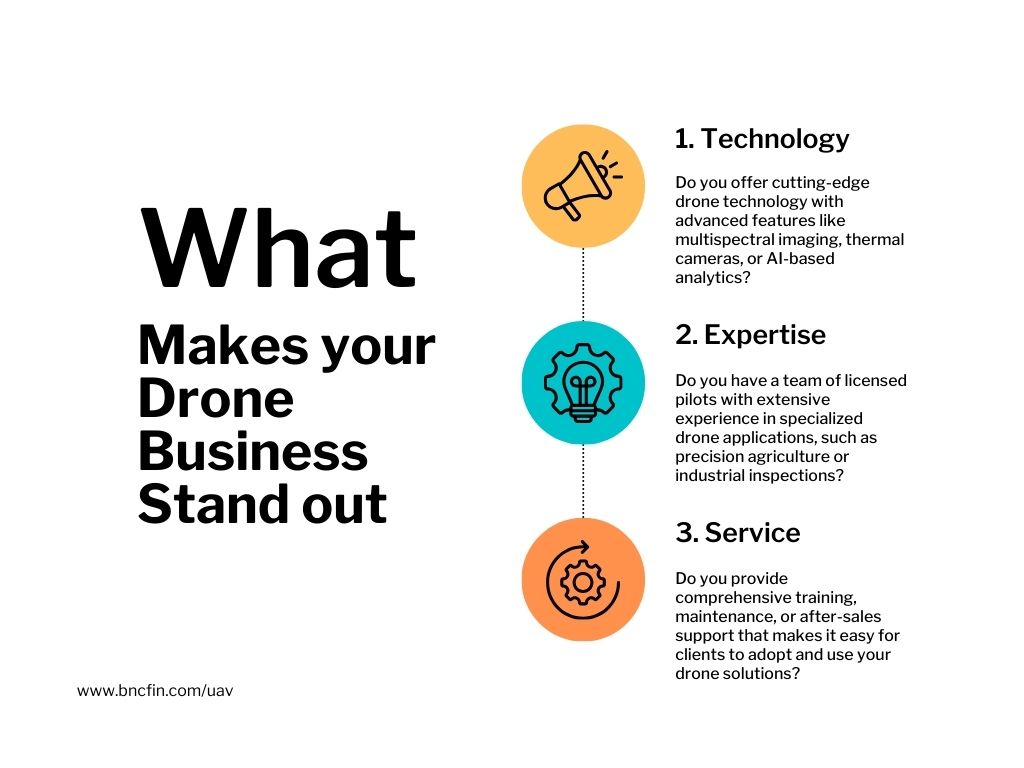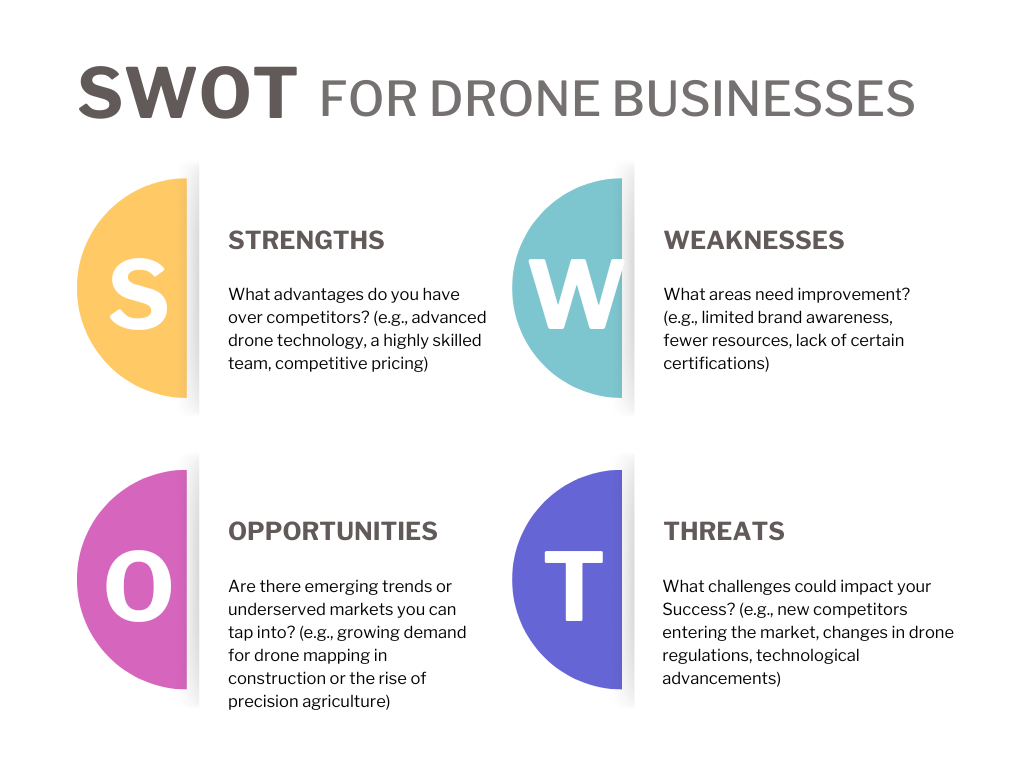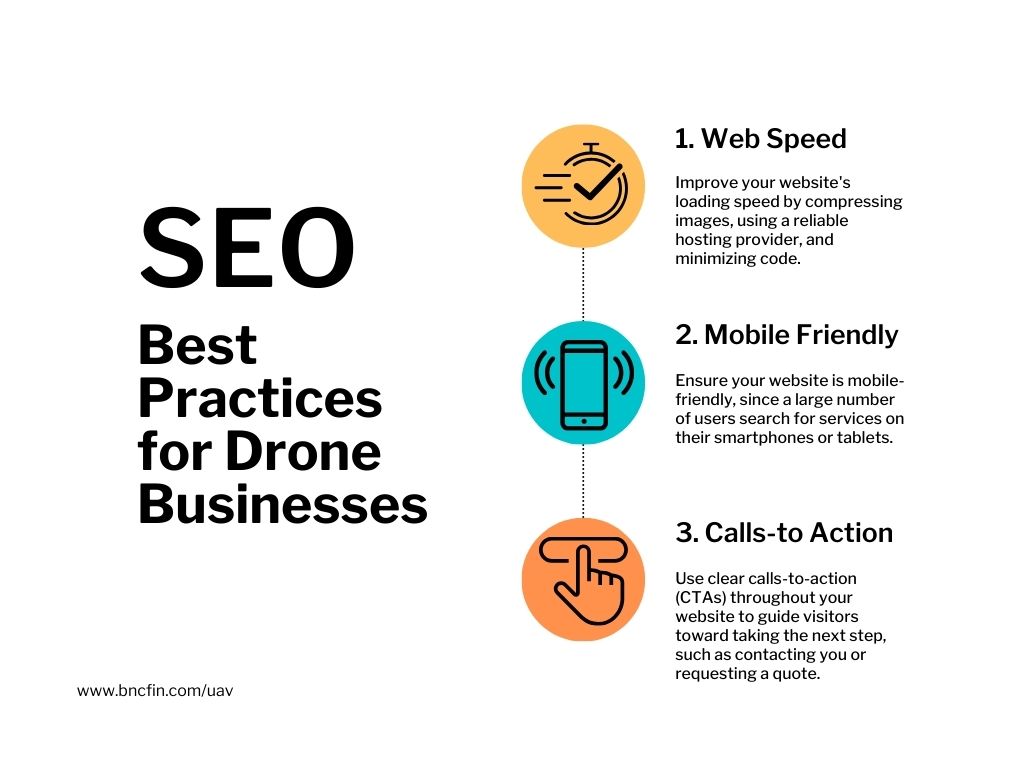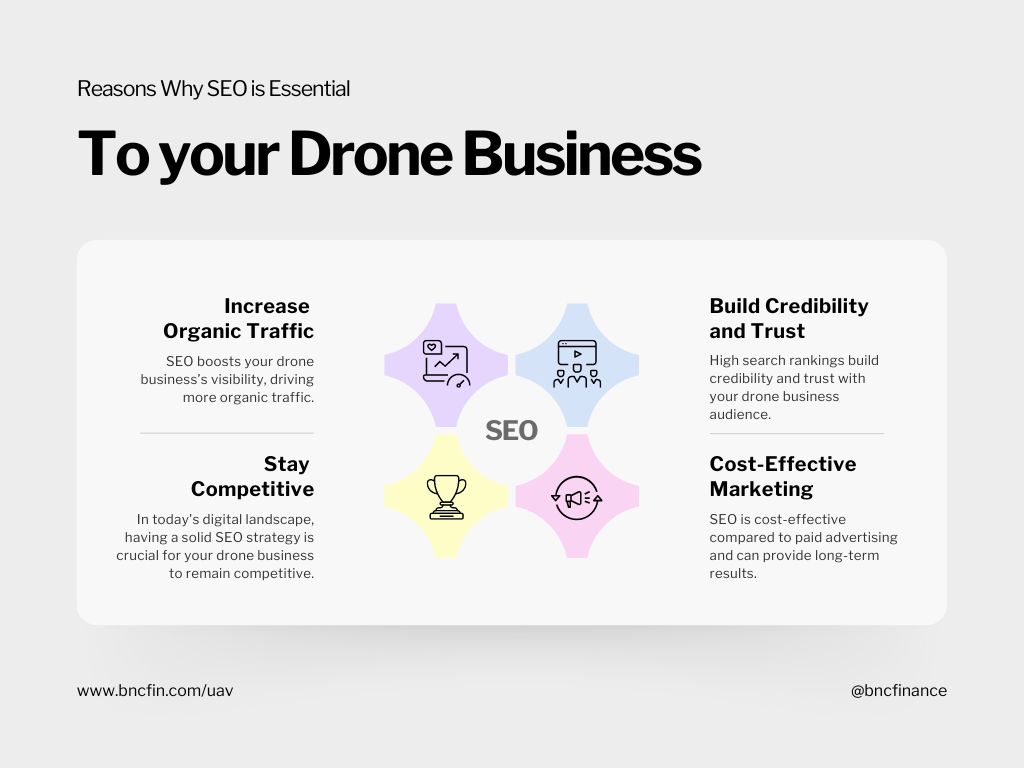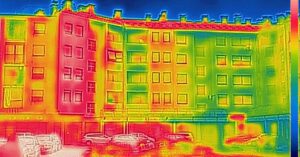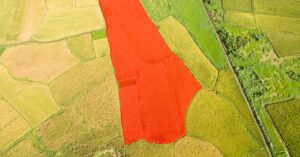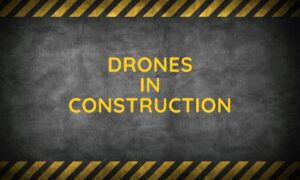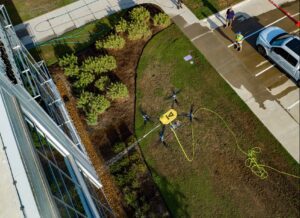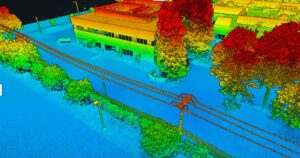Introduction
The drone industry has seen significant growth over the last decade, evolving from a niche hobbyist market into a multi-billion-dollar industry with applications spanning various sectors, including agriculture, construction, real estate, filmmaking, logistics, and public safety. Based on recent industry reports, the commercial drone market is projected to surpass $40 billion dollars by 2025. This growth is attributed to advancements in drone technology, wider adoption across various industries, and an increase in the range of applications. As competition becomes more fierce, drone companies need to distinguish themselves and efficiently connect with their target audience in order to thrive.
Effective marketing is crucial for drone businesses to stand out, bring in new clients, and build a strong brand presence in this dynamic and rapidly growing market. Potential customers range from individual drone enthusiasts to large corporations, and a well-planned marketing strategy ensures that your business communicates its value proposition clearly, engages potential clients, and converts leads into long-term customers. Whether you offer drone services, sell drone products, or provide drone-related training, having a robust marketing plan is essential to staying ahead in this competitive landscape.
This guide is designed to help you navigate the complexities of marketing your drone business. From identifying your target audience and building your brand to mastering digital and offline marketing tactics, this comprehensive guide for drone businesses will provide you with practical strategies and actionable insights. Whether you're just starting out or looking to expand your existing marketing efforts, this guide will equip you with the tools and knowledge needed to create a powerful drone marketing strategy that drives growth and positions your drone business for long-term Success.
Table of Contents
Chapter 1: Understanding Your Drone Business and Market
A solid foundation is important for any successful marketing strategy, and it starts with understanding your drone business and the market in which it operates. By clearly defining your target audience, identifying what makes your business unique, and analyzing your competition, you'll be better equipped to create a marketing plan that resonates with potential customers and sets you apart in the crowded drone industry.
1. Identifying Your Target Audience
For drone businesses, your target audience is the foundation of your marketing strategy. To create an effective approach, you need to identify who they are and customize your messaging to address your audiences specific pain points, needs and interests in the drone industry.
Drone Service Providers vs. Drone Product Sellers:
- Drone Service Providers: These businesses offer services such as aerial photography, mapping, surveying, inspection, agricultural monitoring, or cinematography. Your target audience might include real estate agents, construction companies, farmers, filmmakers, or government agencies.
- Drone Product Sellers: If you sell drones, accessories, or drone-related software, your audience may include other drone service providers, hobbyists, professional photographers, or industry-specific companies that use drones for their operations.
Commercial vs. Consumer Markets:
- Commercial Market: This includes businesses and organizations that use drones for professional purposes (e.g., infrastructure inspections, agricultural mapping, land surveying). B2B (Business-to-Business) marketing strategies are essential here, focusing on how your drones or services can increase efficiency, reduce costs, or solve industry-specific challenges.
- Consumer Market: This market targets individual consumers, such as hobbyists or photographers, who use drones for personal projects. B2C (Business-to-Consumer) marketing should focus on the fun, creativity, and personal benefits that your drones offer.
Pro Tip: Create buyer personas for each segment of your target audience. Include details like demographics, job titles, pain points, goals, and how your drone business can address their needs.
2. Defining Your Unique Selling Proposition (USP)
Your Unique Selling Proposition (USP) sets your drone business apart from the competition. It's a statement that explains why your customers should choose you over others in the market. A strong USP should be clear, concise, and focused on your value.
What Makes Your Drone Business Stand Out?
- Technology & Innovation: Do you offer cutting-edge drone technology with advanced features like multispectral imaging, thermal cameras, or AI-based analytics?
- Expertise & Experience: Do you have a team of licensed pilots with extensive experience in specialized drone applications, such as precision agriculture or industrial inspections?
- Exceptional Customer Service: Do you provide comprehensive training, maintenance, or after-sales support that makes it easy for clients to adopt and use your drone solutions?
Examples of Effective USPs in the Drone Industry:
- "Empowering farmers with precision agriculture drone solutions for maximum crop yield."
- "Your trusted partner in aerial inspections with industry-leading drone technology and certified pilots."
- "High-quality drones with top-notch training and support – perfect for hobbyists and professionals alike."
Pro Tip: Incorporate your USP into all your marketing materials, from your drone business website and social media profiles to your sales pitches and email campaigns. This consistency reinforces your brand identity as a drone business and helps establish a recognizable position in the market.
3. Analyzing Competitors
In order to establish a unique position for your drone business, it's important to understand your competitors and how you can set yourself apart. Analyzing other drone service providers will help you identify their strengths and weaknesses, and allow you to take advantage of opportunities that they may overlook.
Identifying Top Competitors:
- Start by researching other drone businesses offering similar services or products.
- Use search engines, social media, industry directories, and online forums to identify who's operating in your space.
- Pay attention to local competitors and national/international players if your market exceeds your immediate area.
How to Conduct a SWOT Analysis for Your Drone Business:
A SWOT (Strengths, Weaknesses, Opportunities, and Threats) analysis helps you evaluate your drone business in relation to your competitors.
- Strengths: What advantages do you have over competitors? (e.g., advanced drone technology, a highly skilled team, competitive pricing)
- Weaknesses: What areas need improvement? (e.g., limited brand awareness, fewer resources, lack of certain certifications)
- Opportunities: Are there emerging trends or underserved markets you can tap into? (e.g., growing demand for drone mapping in construction or the rise of precision agriculture)
- Threats: What challenges could impact your Success? (e.g., new competitors entering the market, changes in drone regulations, technological advancements)
Pro Tip: Regularly update your SWOT analysis to keep up with market changes, emerging trends, and shifts in the competitive landscape. This ensures your marketing strategy stays relevant and effective.
Key Takeaways from Chapter 1
- Defining your target audience enables you to customize your marketing efforts more effectively.
- Defining your USP helps you stand out in a crowded drone market.
- Conducting a SWOT analysis allows you to position your drone business strategically against competitors.
By understanding your drone business and the market you operate in, you lay the groundwork for a successful marketing strategy. With this knowledge, you're ready to build your brand and create a strong presence that resonates with your audience.
Chapter 2: Building Your Brand for Drone Businesses and Service Providers
In today's competitive drone industry, it is crucial to build a strong and recognizable brand in order to stand out and attract clients. Your brand isn't just your logo or company name; it's the experience and perception that customers associate with your business. A well-defined brand helps build trust, credibility, and loyalty, making converting leads into long-term clients easier. This chapter will guide you through the essentials of establishing a compelling brand identity and building trust in your drone business.
1. Creating a Strong Brand Identity
Your brand identity is how your drone business is visually and verbally represented. It encompasses elements like your logo, color scheme, and brand voice, creating a cohesive and memorable image that resonates with your target audience.
Logo, Color Scheme, and Brand Voice:
- Logo: Your logo is often the first thing potential clients notice about your brand. For drone businesses, the logo should reflect the technology, innovation, and professionalism of your services. Aim for a clean, modern, and easily recognizable design.
- Example: A logo with a stylized drone icon integrated into the company name or using elements representing flight, technology, or aerial views.
- Color Scheme: Choose colors that convey the essence of your drone business. Blue often represents trust and professionalism, while green can signify growth and technology. Select 2-3 primary colors and 1-2 secondary colors that complement each other.
- Example: A drone service provider specializing in agricultural mapping might choose green and blue to reflect nature and technology.
- Brand Voice: Your brand voice is how you communicate with your audience, whether through your website, social media, or marketing materials. It should reflect your company's personality and values. Consider whether your tone is professional, authoritative, friendly, approachable, or innovative and cutting-edge.
Consistent Branding Across Platforms:
- Ensure that your branding elements (logo, color scheme, typography, and voice) are consistent across all platforms, including your website, social media profiles, marketing materials, and emails.
- Consistency helps establish brand recognition and builds trust among your audience. Whether a potential client finds you on LinkedIn, Facebook, or your website, they should have a seamless experience with your brand.
Pro Tip: Create a brand style guide that outlines your logo usage, color codes, typography, and brand voice. This guide will ensure that everyone in your company maintains consistency across all marketing channels.
2. Establishing Trust and Credibility
In the drone industry, where regulations and safety are paramount, establishing trust and credibility is essential for gaining the confidence of potential clients. Demonstrating your expertise, professionalism, and commitment to quality will set you apart from competitors.
Certifications (e.g., Part 107), Licenses, and Partnerships:
- FAA Part 107 Certification: If you're operating a drone business in the U.S., having an FAA Part 107 certification is crucial for conducting commercial drone operations legally. To build trust, display your Part 107 certification prominently on your website and marketing materials.
- Example: Include a "Certified Part 107 Pilot" badge on your website and social media profiles to show potential clients that you're qualified and compliant with regulations.
- Additional Certifications and Training: Highlight any advanced training or certifications relevant to your drone services, such as thermography certification, GIS (Geographic Information Systems) training, or safety courses. These credentials can set you apart as an expert in specialized drone services.
- Partnerships and Affiliations: Partnering with reputable organizations, equipment dealers, or industry associations can enhance your credibility. Consider collaborating with drone manufacturers, software providers, or industry groups to demonstrate your connections and expertise.
Customer Testimonials and Case Studies:
- Gathering Testimonials: Reach out to satisfied clients and request testimonials to showcase positive experiences with your drone services. Include testimonials on your website, social media, and marketing materials.
- Example: A real estate agent who praises your aerial photography for helping sell a property faster is a powerful endorsement of your drone services.
- Creating Case Studies: Case studies provide real-world examples of your drone services' capabilities and expertise, showcasing how they solved specific problems or delivered exceptional results for clients.
- Example: Develop a case study on how your drone mapping services helped a construction company save time and money during a project, including before-and-after images and measurable results.
Pro Tip: Video testimonials can be even more impactful. Ask clients to share their experience on camera and use these videos on your website, social media, or YouTube channel.
Key Takeaways from Chapter 2
- A strong brand identity comprises a professional logo, a consistent color scheme, and a distinct brand voice, ensuring that your drone business is easily recognizable and memorable.
- Having consistent branding across all platforms helps to build trust and reinforce your company's image.
- Certifications, partnerships, customer testimonials, and case studies establish credibility and demonstrate your expertise in the drone industry.
By placing emphasis on developing a robust brand identity and establishing trust and credibility, you'll lay a solid foundation that positions your drone business as a leader in the industry. This groundwork will attract potential clients and leave a lasting impression that motivates them to choose your services over the competition.
Chapter 3: Developing a Digital Marketing Strategy for Drone Businesses
A successfully implemented digital marketing strategy is essential for drone businesses and service providers to expand their audience, improve brand awareness, and generate leads. By optimizing your website, utilizing SEO best practices, and developing high-quality content, you can effectively establish your online presence and attract potential clients.
1. Website Optimization
Your website functions as the virtual storefront for your drone business. It's frequently the first impression that potential clients get of your brand, so creating a user-friendly, informative, and visually appealing website showcasing your services and expertise is crucial.
Essential Pages for Drone Businesses:
- Home: Your homepage should provide an overview of your drone business, highlight your unique selling proposition (USP), and guide visitors to explore your services more. Use high-quality drone footage or images to capture attention.
- Services: Detail the drone services you offer, such as aerial photography, mapping, inspections, or surveying. Include clear descriptions, benefits, and examples of each service, and consider creating individual pages for specialized services.
- About: Share your company's story, mission, vision, and the team behind your drone business. Highlight your certifications, experience, and expertise to build trust.
- Portfolio: Showcase your past work, including photos, videos, or project case studies, to demonstrate your capabilities. Include specifics about each project, like the client, industry, and the results achieved.
- Contact: Ensure potential clients can easily reach you by offering a contact form, phone number, email, and social media links. Consider adding a "Request a Quote" option for leads who want more information.
SEO Best Practices for Drone Businesses:
- Improve your website's loading speed by compressing images, using a reliable hosting provider, and minimizing code.
- Ensure your website is mobile-friendly, since a large number of users search for services on their smartphones or tablets.
- Use clear calls-to-action (CTAs) throughout your website to guide visitors toward taking the next step, such as contacting you or requesting a quote.
Pro Tip: Implement Google Analytics to track website traffic, user behavior, and conversion rates. This data will help you understand which pages perform well and identify areas for improvement.
2. Search Engine Optimization (SEO)
Incorporating SEO in your digital marketing strategy is crucial, helping your drone business rank higher on search engines like Google and making it easier for potential clients to discover you. By targeting relevant keywords, you improve your website's visibility and bring in more targeted traffic.
Identifying High-Ranking Keywords for Drone Services/Products:
- Use Google Keyword Planner and similar tools to carry out keyword research, SEMrush, or Ahrefs to identify popular search terms related to your drone services.
- Concentrate on long-tail keywords that are tailored to your niche (e.g., "drone aerial mapping services," "commercial drone inspections," or "agricultural drone applications").
- If you serve a specific area, include location-based keywords, such as "drone services in Los Angeles" or "drone photography in Miami."
On-Page and Off-Page SEO Strategies:
- On-Page SEO: Improve your page rankings by incorporating relevant keywords into titles, meta descriptions, headers, and body content. Use internal links to connect related pages, creating a seamless navigation experience.
- Example: Optimize your Services page with headers like "Professional Drone Photography Services" and include detailed descriptions of each service.
- Off-Page SEO: To improve your domain authority, build backlinks from reputable websites. To get your website listed, reach out to industry blogs, drone associations, or local business directories.
- Example: Write guest posts on drone-related websites or participate in interviews to earn valuable backlinks.
Pro Tip: Consistently refresh your website's content to keep it current and relevant, as search engines prefer sites with the latest information.
3. Content Marketing
Using content marketing allows you to connect with your ideal audience, display your knowledge, and improve organic traffic to your website. By delivering high-quality, valuable content, your drone business can stand out as an industry leader and capture the interest of potential clients.
Blogging Topics Related to Drone Applications and Industry Trends:
- Share insights about how drones are being used across various industries, such as construction, agriculture, real estate, or cinematography.
- Discuss the latest drone technology trends, regulations, and best practices.
- Offer tips and advice for businesses looking to integrate drones into their operations.
Example Blogging Topics:
- "Top 5 Ways Drones Are Revolutionizing Construction Site Management"
- "A Guide to Using Drones for Precision Agriculture: Benefits and Best Practices"
- "Understanding the Latest FAA Drone Regulations for Commercial Pilots"
Creating Guides, How-Tos, and Case Studies:
- Develop comprehensive guides that educate your audience on topics like drone financing, equipment selection, and choosing the right drone service provider.
- Create step-by-step tutorials demonstrating your expertise, such as "How to Plan a Successful Drone Survey" or "Aerial Photography Tips for Real Estate Marketing."
- Publish case studies showcasing successful projects and your drone services' impact on clients' businesses. Include before-and-after visuals and measurable results.
Video Marketing on YouTube, Vimeo, and Social Media:
Creating videos offers a highly engaging method to showcase your drone services. Create video content demonstrating your expertise, highlighting your projects, or educating your audience about drone applications.
Video Ideas:
- "How Drone Mapping Can Save Time and Money in Construction Projects"
- "Behind the Scenes: A Day in the Life of a Commercial Drone Pilot"
- "Drone Footage Compilation: Stunning Aerial Views from Our Latest Projects"
Share your videos across platforms like YouTube and Vimeo, and promote them on social media channels such as Instagram, Facebook, LinkedIn, and TikTok.
Pro Tip: Incorporate relevant drone industry keywords and hashtags in your blog posts, videos, and social media content to boost visibility and engage a larger audience. Focus on terms like #DroneServices, #AerialPhotography, #UAVTechnology, #DroneMapping, #DroneFinancing, and #DroneBusiness. Using these keywords strategically can help your content reach more drone enthusiasts, potential clients, and industry professionals.
Key Takeaways from Chapter 3
- A well-optimized website is the foundation of your digital marketing strategy. Ensure it includes essential pages and is user-friendly, mobile-responsive, and optimized for SEO.
- SEO assists your drone business in ranking higher in search engine results, simplifying the process for potential clients to find you.
- Content marketing, including blogging, video marketing, and case studies, effectively engages your target audience and establishes your drone business as an industry leader.
Implementing a well-rounded digital marketing strategy focused on website optimization, SEO, and content marketing will help you strengthen your online presence, generate more leads, and scale your drone business.
Chapter 4: Social Media Marketing for Drone Service Businesses
Social media marketing is essential for drone service businesses to showcase their work, connect with potential clients, and build brand awareness. The right social media strategy can help you reach a wider audience, generate leads, and establish your business as a trusted provider of drone services. In this chapter, we'll cover choosing the right social media platforms, creating engaging content, and interacting with your audience to grow your drone service business.
1. How to Choose the Right Social Media Platform
Selecting the most suitable social media platform is crucial for effectively promoting your drone services. Each platform offers unique opportunities to highlight aerial skills, connect with potential clients, and showcase the value of your drone business. For example, use Instagram and TikTok for eye-catching aerial footage, LinkedIn to network with industry professionals, and YouTube for in-depth tutorials and drone service demonstrations. Tailoring your content to each platform will improve your reach and impact in the drone industry.
Instagram:
Why Use It: Instagram is a highly visual platform perfect for displaying stunning aerial shots, videos, and project highlights. It's ideal for showcasing your portfolio and attracting clients who appreciate the visual impact of drone services.
Best Practices:
- Use high-resolution images and videos of your drone projects.
- Utilize Instagram Stories and Reels to share short, engaging clips of your work, including behind-the-scenes footage of drone operations, equipment setup, or drone flight tips.
- Add location tags and relevant hashtags like #DronePhotography, #AerialSurvey, or #DroneServices to increase visibility.
Facebook:
Why Use It: Facebook is excellent for reaching a broad audience, including both B2B and B2C clients. It's a versatile platform for sharing a mix of content, including videos, blog posts, and customer testimonials.
Best Practices:
- Create a business page with detailed service descriptions, contact information, and links to your website.
- Share completed drone projects, client success stories, and educational content about the benefits of drone services.
- Join and participate in Facebook Groups related to drone technology or your target industries (e.g., real estate, construction, agriculture).
LinkedIn:
Why Use It: LinkedIn is ideal for B2B marketing, making it a great platform for connecting with professionals, businesses, and industry leaders who may need drone services.
Best Practices:
- Share articles, case studies, and thought leadership content demonstrating your drone services expertise.
- Connect with potential clients, industry professionals, and decision-makers in your target markets (e.g., real estate developers and construction managers).
- Post project updates, company milestones, and industry trends to stay visible and build credibility.
YouTube:
Why Use It: YouTube is the go-to platform for video content and is perfect for showcasing your drone projects, tutorials, and service capabilities.
Best Practices:
- Create playlists highlighting different services (e.g., Aerial Photography, Mapping & Surveying, Inspection Services).
- Upload high-quality videos showing drone footage from completed projects, explaining the benefits of drone services, or offering educational tutorials.
- Optimize video titles, descriptions, and tags with relevant keywords to improve search visibility.
TikTok:
Why Use It: TikTok is an emerging platform great for reaching a younger audience and sharing quick, creative content.
Best Practices:
- Use TikTok to create engaging short videos showing behind-the-scenes clips, drone tricks, quick tips, or before-and-after shots of your projects.
- Participate in trending challenges or use popular sounds to increase your visibility.
2. Content Ideas for Social Media
To stand out on social media, you need to create content that showcases your drone services in an engaging and informative way. Here are some content ideas tailored for drone service businesses:
Showcasing Drone Projects:
- Share videos and photos of your recent projects, such as aerial shots of construction sites, real estate properties, or agricultural fields.
- Highlight different stages of a project to show how drone services can provide valuable insights or visuals.
- Use time-lapse videos to demonstrate the progress of a construction project or landscape over time.
Behind-the-Scenes Footage:
- Show the preparation process for a drone flight, including setting up equipment, planning flight paths, and performing safety checks.
- Capture drone pilots in action to give your audience a glimpse into what it takes to deliver professional drone services.
- Share stories about challenges you faced during a project and how you overcame them, showcasing your problem-solving skills.
Educational Content:
- Create videos or posts explaining how drone services can benefit specific industries (e.g., "How Drones Are Transforming Real Estate Marketing" or "5 Ways Drones Improve Crop Monitoring for Farmers").
- Offer tips on using drones effectively, such as "Top 3 Tips for Capturing the Best Aerial Photos" or "Understanding Drone Regulations for Commercial Projects."
- Share insights into drone technology advancements and how they improve your services.
Utilizing Instagram Stories, Reels, and TikTok Videos:
- Use Instagram Stories and TikTok to share short clips of drone flights, project highlights, or interesting facts about your services.
- Create Reels showcasing before-and-after comparisons, drone tricks, or quick tutorials.
- Use Stories to share daily updates, answer FAQs, or provide sneak peeks of upcoming projects.
3. Engaging Your Audience
Building a loyal social media following hinges on engagement. When you interact with your audience, you foster trust, enhance visibility, and motivate potential clients to consider your drone services.
Using Polls, Quizzes, and Q&A Sessions:
- Use Instagram Stories, Facebook, or LinkedIn to create polls and quizzes about drone services, applications, or industry trends (e.g., "Which industry do you think benefits the most from drone technology?").
- Host live Q&A sessions where you answer common questions about drone services, technology, or how your business operates. This can help showcase your expertise and build credibility.
- Use LinkedIn and Facebook to share survey polls on topics like "What drone service are you most interested in?"
Encouraging User-Generated Content and Reviews:
- Ask satisfied clients to share photos or videos of your drone services in action and tag your business on social media.
- Create a branded hashtag (e.g., #DronesBy[YourBusinessName]) and encourage clients to use it when sharing their own content.
- Highlight customer testimonials and reviews on your social media profiles to build credibility and showcase the positive experiences others have had with your drone services.
Pro Tip: Address comments, messages, and mentions in a timely manner. This engagement reflects that you value your audience's input and prioritize providing exceptional customer service.
Key Takeaways from Chapter 4
- Choosing the right social media platforms helps you reach your target audience more effectively. Instagram, Facebook, LinkedIn, YouTube, and TikTok each offer unique opportunities for promoting your drone services.
- Creating engaging content, such as showcasing drone projects, behind-the-scenes footage, and educational materials, is crucial for demonstrating your expertise and building a strong online presence.
- Actively engaging your audience through polls, quizzes, Q&A sessions, and user-generated content helps build trust, credibility, and a loyal following.
By leveraging social media marketing, your drone service business can effectively connect with potential clients, showcase your skills, and establish your brand as a trusted provider in the drone industry.
Chapter 5: Email Marketing and Lead Generation for Drone and UAV Businesses
For drone and UAV businesses, email marketing stands out as one of the most efficient methods for nurturing leads and converting them into customers. By establishing a targeted email list, delivering valuable content, and utilizing automated campaigns, you can connect with potential clients and stay top-of-mind. This chapter will cover the steps for building your email list, creating successful email campaigns, and transforming leads into loyal customers.
1. Building an Email List
Building a solid email list serves as the backbone of your email marketing efforts. Collecting email addresses from potential clients interested in drone services allows you to establish a direct connection and cultivate these leads over time.
Lead Magnets:
- Drone Checklists: Offer downloadable checklists, such as "Essential Pre-Flight Checklist for Drone Pilots" or "Drone Maintenance Guide," to attract potential clients who want to learn more about drone operations.
- eBooks: Create comprehensive eBooks on topics like "The Ultimate Guide to Drone Photography" or "How Drones Are Transforming Agriculture" to position your business as an industry expert.
- Webinars: Host webinars on industry-specific topics such as "Using Drones for Construction Site Inspections" or "Leveraging UAVs for Precision Agriculture" to engage your target audience and capture their contact information.
Sign-Up Forms on Your Website and Social Media:
Website: Include sign-up forms on your website's homepage, blog, and landing pages. Offer an incentive (e.g., a free eBook or checklist) to encourage visitors to subscribe.
Social Media: Utilize social media channels to advertise your lead magnets and guide traffic to your email sign-up form. Create posts with compelling calls to action, inviting your followers to join your email list to receive exclusive content and stay updated.
Pro Tip: Make the sign-up process simple and quick. Ask for only essential information (e.g., name and email address) to reduce friction and increase sign-up rates.
2. Creating Effective Email Campaigns
After building your email list, engage your subscribers with valuable content that keeps them informed, engaged, and excited to learn more about your drone services.
Newsletters with Industry Updates and Drone Tips:
- Industry News: Share updates on drone regulations, technology advancements, and industry trends to inform your audience about what's happening in the drone and UAV space.
- Drone Tips: Provide actionable tips on topics such as "How to Capture Stunning Aerial Photos," "Best Practices for Safe Drone Operations," or "Understanding FAA Regulations for Commercial Drone Pilots." Using this helps to position your business as a valuable resource.
- Project Highlights: Include a section showcasing recent drone projects you've completed, along with before-and-after photos or videos to demonstrate the impact of your services.
Case Studies and Testimonials to Build Credibility:
- Case Studies: Share detailed case studies highlighting how your drone services solved a problem or delivered exceptional results for a client. Include specifics like project goals, challenges, solutions, and measurable outcomes (e.g., "How Our Drone Mapping Services Helped a Construction Company Save 20% on Project Costs").
- Testimonials: Include quotes about positive experiences from satisfied clients who have used your services. This adds credibility and reassures potential customers that your drone business is reliable and trustworthy.
Pro Tip: Your emails should contain a combination of promotional, educational, and engaging content to keep subscribers interested without overwhelming them with sales pitches.
3. Nurturing Leads into Customers
Effective email marketing isn’t just about collecting contacts and sending periodic updates; it’s about nurturing potential clients through the sales funnel until they choose your drone business. Achieving this requires ongoing engagement through drip campaigns and automated follow-up sequences.
Drip Campaigns and Automated Follow-Ups:
- Welcome Series: Create a set of welcome emails for new subscribers, presenting your drone business, detailing your services, and emphasizing your unique value proposition. Share a short preview of what they can expect from your email communications and incorporate a call-to-action (e.g., "Schedule a Free Consultation").
- Educational Drip Campaigns: Create a sequence of educational emails that provide valuable insights into the drone industry, such as "Understanding the Benefits of Drone Inspections" or "How Drones Can Improve Your Marketing Efforts." This positions your business as an expert and builds trust.
- Promotional Drip Campaigns: Send targeted emails promoting specific services, limited-time offers, or discounts to encourage subscribers to take action. For example, offer a "20% Discount on Your First Aerial Survey" to incentivize leads to become paying customers.
- Follow-Up Sequences: Implement automated follow-up emails for subscribers who express interest in your services (e.g., by downloading a lead magnet or requesting a quote). Remind them of the benefits of working with your drone business and invite them to take the next step.
Pro Tip: Divide your email list according to criteria like industry, service interest, or engagement level. This approach enables you to provide more personalized and relevant content, enhancing the chances of conversion.
Key Takeaways from Chapter 5
- Building an email list using lead magnets and sign-up forms is crucial for establishing direct communication with potential clients interested in drone services.
- Creating effective email campaigns with newsletters, case studies, and testimonials helps engage subscribers, build credibility, and position your drone business as an industry leader.
- Nurturing leads with drip campaigns and automated follow-ups ensures that you stay top of mind and guide potential clients through the sales funnel.
By implementing these email marketing and lead generation strategies, your drone and UAV business can establish meaningful connections with potential clients, build trust, and ultimately convert leads into loyal customers.
Chapter 6: Paid Advertising for Drone Businesses
Paid advertising effectively boosts visibility, reaches a larger audience, and generates leads for your drone business. By utilizing platforms like Google Ads, social media advertising, and retargeting campaigns, you can attract potential clients actively searching for drone services. In this chapter, we'll explore how to implement a paid advertising strategy tailored for drone businesses, focusing on Google Ads, social media advertising, and retargeting campaigns.
1. Google Ads and SEO
Google Ads is a tool for driving traffic to your website and reaching people actively searching for drone services or products. By targeting relevant keywords and optimizing your campaigns, you can ensure your ads appear for potential clients when they need your services.
Targeting Keywords Related to Drone Services/Products:
- Keyword Research: For Keyword Research on your drone business Use tools such as Google Keyword Planner, SEMrush, or Ahrefs to identify high-intent keywords related to your drone business. Focus on terms like "drone aerial photography," "drone surveying services," "commercial drone inspections," or "UAV mapping services."
- Long-Tail Keywords: Target long-tail keywords specific to phrases your audience might search that are more specific and less competitive, such as "agricultural drone mapping services" or "drone roof inspection for insurance claims."
- Ad Copy: Write compelling ad copy highlighting your services, expertise, and unique selling points. Include a strong call-to-action (CTA), such as "Request a Free Quote" or "Schedule a Drone Demo Today."
Using Local SEO for Targeted Campaigns:
- Location Targeting: If your drone business serves a specific geographic area, use location targeting to ensure your ads are reaching potential clients in your service area. For example, target keywords like "drone services in Los Angeles" or "drone inspection in Miami."
- Google My Business: Set up and optimize your Google My Business profile with accurate business information, service offerings, photos, and customer reviews. This improves your visibility in local searches and can attract clients searching for drone services in your area.
Pro Tip: Monitor your Google Ads campaign performance regularly, adjusting your targeting, budget, and ad copy to maximize your return on investment (ROI).
2. Social Media Advertising
Social media advertising gives your drone business the ability to reach a bigger audience and showcase your drone services through visual storytelling. You can create very specific targeteded ads that resonate with potential clients by leveraging platforms like Facebook, Instagram, and LinkedIn.
Facebook and Instagram Ads for Visual Storytelling:
- Facebook Ads: Use Facebook's detailed targeting options to reach specific demographics, interests, and behaviors relevant to your drone business. For example, target real estate professionals, construction managers, or farmers who might benefit from your services.
- Create carousel ads to showcase multiple drone projects, videos, or before-and-after comparisons, demonstrating the impact of your services.
- Use video ads to capture attention and highlight your drone capabilities in action, such as aerial footage of construction sites, real estate properties, or agricultural fields.
- Instagram Ads: Instagram is ideal for sharing visually engaging content. Utilize Instagram Stories and Reel ads to create short, dynamic videos showcasing your drone projects or services.
- Include captivating visuals, clear messaging, and a strong CTA to encourage viewers to learn more about your drone services.
LinkedIn Ads for B2B Drone Services:
Why Use LinkedIn: LinkedIn is the go-to platform for B2B marketing and allows you to connect with indusrty professionals that can benefit from your drone services, such as construction, real estate, or agriculture.
- Ad Formats: Use LinkedIn Sponsored Content, InMail, and Text Ads to reach decision-makers in your target industries.
- Share case studies, industry insights, or project highlights to showcase your expertise and build credibility.
- Use LinkedIn Lead Gen Forms to capture contact information from potential clients without requiring them to leave the platform.
Pro Tip: Test different ad formats, visuals, and messaging to see what works best with your audience on each platform. Then, monitor ad performance regularly and optimize your campaigns for better results.
3. Retargeting Campaigns
Re-engage potential clients who showed interest in your drone services but haven't acted with retargeting campaigns. By targeting website visitors or social media followers, you can remind them of your offerings and encourage them to revisit your business.
How to Retarget Website Visitors and Social Media Followers:
- Website Retargeting: Utilize Google Ads or Facebook Pixel to monitor visitors to your website and display ads to them while they browse other websites or social media platforms. For instance, if someone viewed your "Drone Inspection Services" page but didn't request a quote, retarget them with ads emphasizing the advantages of your inspection services.
- Social Media Retargeting: Retarget people who have engaged with your social media posts, videos, or ads but haven't converted. Create ads that offer additional information, special promotions, or incentives that encourage them to take the next step.
- Dynamic Retargeting: Use dynamic retargeting to show personalized ads based on the pages or services visitors viewed on your website. For example, if a visitor looks at your "Drone Mapping" service, show them ads featuring mapping projects, testimonials, or a limited-time discount.
Pro Tip: Retargeting campaigns work best when combined with compelling offers, such as a free consultation, discount, or downloadable resource, to entice potential clients to return and take action.
Key Takeaways from Chapter 6
- Google Ads allows you to target keywords related to drone services and products, helping you reach potential clients actively searching for your services.
- Social media advertising on platforms like Facebook, Instagram, and LinkedIn enables you to showcase your drone services through visual storytelling and connect with specific audiences.
- Retargeting campaigns help you re-engage website visitors and social media followers, encouraging them to take action and convert into customers.
By implementing a well-rounded paid advertising strategy, your drone business can effectively reach potential clients, increase visibility, and generate more leads, ultimately driving growth and Success.
Chapter 7: Networking and Partnerships for Drone Businesses
Networking and building strategic partnerships are crucial for growing your drone business. By participating in industry events, collaborating with other businesses, and engaging in online communities, you can expand your reach, establish credibility, and create valuable growth opportunities. This chapter will guide you through effective networking and partnership strategies tailored for drone businesses.
1. Participating in Industry Events
Participating and attending industry events is one of the best ways to connect with potential clients, partners, and industry leaders. These events provide the chance to highlight your drone services, stay updated on the latest trends, and establish relationships that can lead to new business opportunities.
Trade Shows, Expos, and Conferences:
Trade Shows and Expos: Attend trade shows and expos such as the Commercial UAV Expo to network with professionals, vendors, and prospective clients who are interested in drone technology and services. These events provide an opportunity to highlight your expertise, demonstrate your services, and interact with decision-makers in industries like construction, agriculture, real estate, and public safety.
Tips for Success:
- Prepare a booth with engaging visuals, videos, and brochures highlighting your services and projects.
- Offer free demonstrations or consultations to attract visitors to your booth.
- Collect contact information from attendees interested in your services and follow up after the event.
Conferences: Attend conferences focused on drone technology or your target industries to learn about the latest developments, gain insights from industry experts, and expand your network. Look for conferences that offer networking sessions, workshops, or panel discussions where you can actively engage with other attendees.
Pro Tip: Consider becoming a speaker or panelist at these events to position yourself as an industry expert and increase your visibility.
2. Building Relationships with Other Businesses
Partnering with other businesses can unlock new opportunities, generate leads, and help you access different markets. Building relationships with complementary businesses can lead to a mutually beneficial collaboration that fosters growth for both parties.
Collaborating with Equipment Dealers, Software Providers, and Industry Influencers:
- Equipment Dealers: Partner with drone equipment dealers to offer their customers financing, training, or support services. This allows you to access their existing customer base and establish your brand as a trusted partner in the drone industry.
- Example: If you specialize in drone inspections, collaborate with equipment dealers who supply drones to construction or agriculture businesses, offering your services as an added value to their clients.
- Software Providers: Work with software providers offering drone data processing, mapping, or analytics solutions. This partnership can enable you to offer comprehensive drone services that combine both hardware and software capabilities.
- Example: Partner with a drone mapping software company to provide end-to-end solutions for clients needing aerial surveys, mapping, or inspections.
- Industry Influencers: Identify influencers and thought leaders in the drone or target industries who can promote your services to their audience. This can be achieved through guest blogging, podcast interviews, social media collaborations, or joint webinars.
Pro Tip: Offer value to your partners by providing them with leads, resources, or exclusive discounts. A win-win approach makes partnerships more effective and long-lasting.
3. Leveraging Online Communities
Engaging with online communities allows you to connect with like-minded professionals, potential clients, and partners in the drone industry. You can establish your business as a knowledgeable and reliable source by participating in discussions, sharing your expertise, and building a presence in these communities.
Engaging in Drone Forums, Groups, and Industry Associations:
- Drone Forums: Participate in well-known drone forums like DIY Drones, MavicPilots, or Commercial Drone Pilots to participate in discussions, share knowledge, and provide insights.These platforms are popular among drone enthusiasts, professionals, and businesses looking for advice and recommendations.
- Example: Participate in discussions about drone regulations, equipment, or best practices for aerial photography. Share tips, answer questions, and build credibility within the community.
- Social Media Groups: Engage in LinkedIn and Facebook groups dedicated to drone technology, services, or industry applications (such as "Commercial Drone Operators," "Drone Pilots for Hire," or "Precision Agriculture with Drones"). Contribute your expertise, respond to questions, and connect with potential clients or partners.
- Industry Associations: Join industry associations like the Association for Uncrewed Vehicle Systems International (AUVSI) or the Drone Service Providers Alliance (DSPA). Membership in these associations provides networking opportunities, access to industry resources, and the chance to participate in exclusive events or webinars.
Pro Tip: Regularly contribute valuable content, such as articles, videos, or tips, to online communities to establish your expertise and build trust within these networks.
Key Takeaways from Chapter 7
- Participating in industry events like trade shows, expos, and conferences allows you to connect with potential clients, partners, and industry leaders while showcasing your drone services.
- Building relationships with other businesses, such as equipment dealers, software providers, and industry influencers, can create mutually beneficial partnerships that drive growth.
- Engaging in online communities, forums, groups, and industry associations helps you establish credibility, expand your network, and gain visibility in the drone industry.
By leveraging networking and partnerships, your drone business can create valuable connections, generate new opportunities, and establish itself as a trusted provider in the industry.
Chapter 8: Offline Marketing Strategies for Drone Businesses
While digital marketing is essential, offline marketing strategies can be just as effective in building relationships, generating leads, and establishing your drone business in your local community. Offline marketing helps you connect with potential clients in person, create a memorable impression, and demonstrate the value of your services. This chapter explores leveraging print marketing materials, workshops, training sessions, and local networking to grow your drone business.
1. Print Marketing Materials
Print marketing materials provide tangible resources that potential clients can take with them, making your drone business more memorable. High-quality printed materials allow you to showcase your services, brand identity, and contact information effectively.
Flyers, Brochures, and Business Cards:
- Flyers: Create eye-catching flyers highlighting your drone services, expertise, and contact details. Distribute these at industry events, trade shows, local businesses, or community centers. Include visuals of your drone projects, a brief description of your services, and a call to action encouraging potential clients to contact you.
- Example: Design a flyer that showcases your aerial photography services for real estate agents, with examples of properties you've photographed and a special offer for first-time clients.
- Brochures: Develop detailed brochures that provide more in-depth information about your services, including case studies, client testimonials, and explanations of how drone technology can benefit different industries. Use high-quality images to showcase your work and ensure the brochure reflects your brand's professionalism.
- Example: Create a brochure for construction companies highlighting how drone mapping can improve site inspections, safety, and project management, including a section on the equipment and software you use.
- Business Cards: Always bring business cards with you to events, meetings, or networking opportunities. Make sure your card features your name, title, business name, contact details, website, and a concise description of your services. A thoughtfully designed business card can leave a memorable impression and make it easy for potential clients to get in touch.
Pro Tip: Use QR codes on your print materials that link directly to your website, service pages, or booking form, making it easy for prospects to learn more about your drone business.
2. Offering Workshops and Training Sessions
Hosting workshops and training sessions is a great way to educate potential clients about drone technology, build trust, and establish yourself as an expert. By sharing your expertise, you can showcase the value of your services and draw in new clients.
Educating Customers About Drone Technology and Services:
- Workshops for Industry Professionals: Host workshops tailored to industries that can benefit from your drone services, such as real estate, construction, agriculture, or environmental monitoring. Demonstrate how drones can enhance their operations, reduce costs, or improve efficiency.
- Example: Offer a "Drone Mapping for Construction Projects" workshop that teaches construction professionals how drone mapping can streamline site inspections, track project progress, and improve safety.
- Training Sessions for Businesses: Offer training sessions for businesses interested in using drones in-house, such as teaching real estate agents how to capture aerial property photos or training agricultural professionals on using drones for crop monitoring. This positions you as a trusted advisor and could lead to ongoing consulting opportunities.
- Hands-On Demonstrations: Conduct live demonstrations of your drone services at events, trade shows, or local business expos. Show attendees how you operate your drone, collect data, or capture stunning aerial footage, and explain the benefits of your services.
Pro Tip: To attract attendees, promote your workshops and training sessions through your website, social media, local event listings, and flyers. Offer discounts or incentives for those who register early.
3. Local Marketing
Local marketing is essential for establishing your drone business within your community. You can generate leads, referrals, and partnerships by building relationships with local businesses and organizations.
Networking with Local Businesses and Joining Chambers of Commerce:
- Networking Events: Attend local networking events, business meetups, or industry-specific gatherings to connect with potential clients, partners, or referral sources. Introduce yourself, share your expertise, and explain how your drone services can benefit their businesses.
- Example: Join a local real estate association and attend their meetings to connect with real estate agents who might need drone photography services for property listings.
- Chambers of Commerce: Join your local chamber of commerce to network with other businesses, access resources, and participate in community events. Many chambers offer opportunities to showcase your business, participate in workshops, or present your services to other members.
- Example: Offer to host a drone demonstration or educational presentation at a chamber of commerce event to introduce your services to other business owners.
- Collaborating with Local Businesses: Form partnerships with nearby complementary businesses, such as real estate agencies, construction companies, or agricultural suppliers, to mutually promote each other's services. This strategy helps you tap into their customer base and boost your presence in the community.
Pro Tip: Sponsor local events, community fairs, or charity functions to increase your brand's exposure and demonstrate your commitment to supporting the community.
Key Takeaways from Chapter 8
- Print marketing materials like flyers, brochures, and business cards are effective offline tools for promoting your drone business and making a memorable impression.
- Offering workshops and training sessions help educate potential clients about drone technology, build trust, and position your business as an expert in the field.
- Local marketing strategies, such as networking with local businesses and joining chambers of commerce, help you establish a presence in your community and generate valuable leads and partnerships.
By integrating offline marketing strategies with your overall marketing plan, your drone business can build stronger connections, establish credibility, and attract more clients in your local area.
Chapter 9: Measuring Your Marketing Success for Drone Service Businesses
Understanding the impact of your marketing efforts is essential for recognizing what’s working, what’s falling short, and how to enhance your strategy. By evaluating key metrics, employing analytics tools, and modifying your approach based on data, you can optimize your marketing campaigns for improved results in your drone service business. This chapter will cover how to track your marketing success and continually refine your strategy.
1. Tracking Key Metrics
Evaluating the effectiveness of your marketing campaigns requires monitoring key metrics that shed light on your overall performance. These metrics will help you understand how well your strategies drive traffic, engagement, and conversions for your drone service business.
Website Traffic:
- Unique Visitors: Track the number of unique visitors to your website to understand how many people are discovering your business.
- Page Views: Monitor which pages are most frequently visited, such as your service pages, blog posts, or portfolio. This helps identify which content resonates with your audience.
- Bounce Rate: Monitor your bounce rate, which reflects the percentage of visitors who exit your website after viewing just one page. A high bounce rate indicates that visitors aren’t finding what they need or that your content requires enhancement.
Social Media Engagement:
- Likes, Shares, and Comments: Measure engagement on your social media posts to see how well your content resonates with your audience. High engagement rates indicate that your followers find your posts valuable or interesting.
- Follower Growth: Monitor the growth of your social media following over time. Consistent growth indicates that your content is effectively attracting and engaging your audience.
- Click-Through Rate (CTR): Monitor how many people are clicking on links in your social media posts, leading them to your website or landing pages.
Email Open Rates and Click-Through Rates:
- Open Rate: Monitor the number of recipients who open your emails to assess the effectiveness of your subject lines and overall email content.
- Click-Through Rate (CTR): Measure the rate at which email recipients click on links in your emails. A high CTR indicates that your content resonates well and drives action.
- Unsubscribe Rate: Keep an eye on your unsubscribe rate to ensure you're not losing subscribers due to irrelevant or overly frequent emails.
Conversion Rates:
- Lead Conversion Rate: Measure the percentage of website visitors who convert on a desired action, such as filling out a form, requesting a quote, or signing up for your newsletter.
- Sales Conversion Rate: Measure the conversion of leads into paying customers to gain insights into the efficiency of your marketing strategies in turning prospects into clients.
Pro Tip: Set specific goals for each metric based on industry benchmarks and your business objectives. This will help you measure progress and implement process improvements.
2. Using Analytics Tools
Analytics tools offer valuable data and insights into your marketing performance. Utilizing these tools allows you to understand your audience better, monitor key metrics, and make informed, data-driven decisions for your drone service business.
Google Analytics:
- Website Traffic: Use Google Analytics to monitor the number of visitors to your website, how they found you (e.g., organic search, social media, paid ads), and which pages they visited.
- Audience Insights: Learn about your audience's demographics, location, device usage, and behavior, helping you tailor your marketing strategies to meet their needs.
- Goal Tracking: Use Google Analytics goals to track specific actions, such as form completions, newsletter sign-ups, or contact inquiries.
Facebook Insights:
- Page Performance: Monitor the performance of your Facebook business page, including metrics like reach, engagement, and follower growth.
- Post Analytics: Identify which posts generate the most engagement, allowing you to create more content that resonates with your audience.
- Audience Insights: Gain insights into your followers' demographics, interests, and behaviors, helping you target your ads more effectively.
Email Marketing Platforms:
- Email Analytics: Utilize email marketing platforms like Mailchimp, Constant Contact, or ActiveCampaign to monitor key metrics like email open rates, click-through rates, and unsubscribe rates.
- Automation Reports: Monitor the performance of your automated email sequences, including drip campaigns and follow-up emails, to understand which emails are driving conversions.
Pro Tip: Regularly analyze your analytics data and compile monthly reports to keep track of your progress and identify key trends.
3. Adjusting Your Strategy Based on Data
The most successful marketing strategies adapt and improve over time. By analyzing and adjusting your data, you can optimize your campaigns and achieve better results for your drone service business.
A/B Testing:
- What to Test: Adjust different elements of your marketing campaigns, such as email subject lines, ad text, website headings, and social media imagery, to see what works best.
- How It Works: Split your audience into two groups and present each group with a different version of your content. Monitor which version performs better and use that data to inform future decisions.
- Example: Test two different email subject lines to see which one results in a higher open rate or test two different call-to-action (CTA) buttons on your website to determine which generates more clicks.
Continuous Improvement:
- Identify Patterns: Regularly analyze your data to identify patterns or trends. For example, if you notice that posts featuring drone project videos generate more engagement, incorporate more videos into your social media strategy.
- Refine Your Targeting: Use your data to refine your targeting efforts. If you discover that a particular audience segment (e.g., real estate agents) is more likely to engage with your content, adjust your campaigns to focus more on that segment.
- Adjust Your Budget: Allocate more budget to the channels or campaigns that are generating the best results, and reduce spending on underperforming areas.
Pro Tip: Set up regular marketing performance reviews, either monthly or quarterly, to assess your progress and make data-driven adjustments.
Key Takeaways from Chapter 9
- Monitoring key metrics such as website traffic, social media engagement, email open rates, and conversion rates is crucial for assessing your marketing success.
- Use analytics tools such as Google Analytics, Facebook Insights, and email marketing platforms to monitor your performance and gain valuable insights.
- Adjust your marketing strategy based on data, using A/B testing and continuous improvement to optimize your campaigns and achieve better results.
By measuring your marketing success and making data-driven decisions, your drone service business can refine its strategies, maximize ROI, and achieve long-term growth.
Chapter 10: Future Trends in Drone Marketing for Drone Service Businesses
As the drone industry continues to evolve, staying ahead of marketing trends is crucial for maintaining a competitive edge. Emerging technologies, sustainability efforts, and advancements in networking capabilities offer new opportunities for promoting your drone services effectively. This chapter explores the future trends in drone marketing and how you can leverage them to enhance your marketing strategy.
1. Adopting Emerging Technologies
The adoption of technologies such as Augmented Reality (AR), Virtual Reality (VR), and Artificial Intelligence (AI) has the potential to revolutionize marketing strategies for drone service businesses. These tools create interactive and immersive experiences, engaging potential clients and demonstrating the value of your drone services in innovative manners.
Augmented Reality (AR):
- AR Applications: AR can create interactive experiences that allow potential clients to visualize drone services in real-world scenarios. For example, real estate agents can use AR to view a property's aerial footage through their smartphones, giving them a better understanding of the layout and features.
- AR Demos: Create AR-enabled business cards or brochures that provide clients with an immersive experience, such as viewing a 3D model of a drone project when they scan your card with their phone.
Virtual Reality (VR):
- Virtual Drone Tours: Offer VR drone tours that allow potential clients to experience your projects as if they were flying the drone themselves. This is particularly useful for showcasing large-scale projects, such as construction sites, real estate developments, or agricultural fields.
- VR Presentations: Use VR headsets during trade shows, conferences, or client meetings to provide an immersive experience, demonstrating your drone services in action and making a memorable impact.
Artificial Intelligence (AI):
- AI-Driven Insights: Leverage AI-powered analytics to gain insights into your marketing performance, target audience behavior, and customer preferences. AI can help you create personalized marketing campaigns, recommend content, and optimize your ads for better engagement.
- Chatbots: Implement AI chatbots on your website to answer frequently asked questions, guide potential clients through your services, and generate leads 24/7.
Pro Tip: Integrating AR, VR, and AI into your marketing strategy can help differentiate your drone service business and create unique, engaging client experiences.
2. Sustainability and Eco-Friendly Marketing
As environmental consciousness grows, more businesses and consumers seek eco-friendly solutions. Highlighting the sustainable aspects of your drone services can help position your business as environmentally responsible and attract clients who prioritize sustainability.
Highlighting Environmentally Friendly Drone Applications:
- Reduced Carbon Footprint: Emphasize how drones can reduce the carbon footprint compared to traditional methods. For example, explain how drone inspections minimize the need for ground vehicles, scaffolding, or helicopters, resulting in lower emissions.
- Conservation and Monitoring: Showcase your involvement in projects that contribute to environmental conservation, such as wildlife monitoring, forest management, or agricultural practices that reduce the use of pesticides and fertilizers.
- Sustainable Data Collection: Promote the efficiency of drone data collection, which minimizes the need for multiple site visits and reduces energy consumption.
Sustainable Marketing Practices:
- Use eco-friendly materials for your print marketing (e.g., recycled paper for flyers and brochures).
- Incorporate green initiatives into your business operations, such as using solar-powered charging stations for your drones or offsetting your carbon emissions through tree-planting programs.
Pro Tip: Share case studies and success stories that highlight the positive environmental impact of your drone services to demonstrate your commitment to sustainability.
3. The Role of 5G and Future Networking Capabilities
The rollout of 5G networks is transforming the capabilities of drone technology, offering faster data transfer, lower latency, and improved connectivity. This advancement can significantly enhance how drone service businesses market their services and interact with clients.
How 5G Can Transform Drone Marketing and Applications:
- Real-Time Data Transmission: With 5G, drones can transmit high-resolution images, videos, and data in real time, enabling you to showcase live drone footage during client presentations, events, or virtual meetings.
- Improved Drone Operations: 5G allows for more precise and reliable drone control, making capturing complex aerial shots or conducting real-time inspections easier. This can be a selling point when marketing to industries that require accurate and timely data, such as construction, agriculture, or infrastructure management.
- Enhanced Client Experience: Offer clients real-time access to drone footage or data through cloud-based platforms, allowing them to monitor progress, make informed decisions, or provide feedback without delays.
Pro Tip: Stay updated on developments in 5G technology and assess how it can enhance your drone services and marketing efforts. Incorporate the benefits of 5G-enabled drone operations into your marketing materials to highlight your dedication to using state-of-the-art technology.
Key Takeaways from Chapter 10
- Adopting emerging technologies like AR, VR, and AI can help create immersive and engaging marketing experiences that showcase your drone services innovatively.
- Emphasizing sustainability and eco-friendly applications can position your drone service business as an environmentally responsible choice, appealing to clients who prioritize green solutions.
- Implementing 5G networks offers enhanced data transmission, improved drone operations, and real-time client experiences, making it a valuable asset for your marketing strategy.
By staying ahead of future trends in drone marketing, your drone service business can adapt to changing market demands, leverage new technologies, and remain competitive in an evolving industry.
Conclusion: Elevating Your Drone Service Business Through Effective Marketing
Marketing your drone service business requires a strategic and multifaceted approach. You must combine digital and offline techniques to reach your target audience, establish credibility, and build lasting relationships. By utilizing the strategies presented in this guide, you'll be well-equipped to attract clients, generate leads, and grow your business in a competitive and ever-evolving market.
Summary of Key Takeaways
- Understanding Your Market: Identifying your target audience and defining your unique selling proposition (USP) sets the foundation for a successful marketing strategy.
- Building a Strong Brand: Establishing a cohesive brand identity and earning trust through certifications, testimonials, and partnerships is essential for standing out in the drone industry.
- Digital Marketing Strategies: A well-optimized website, effective SEO practices, engaging content, and an active social media presence help increase visibility and attract potential clients online.
- Offline Marketing Techniques: Print materials, workshops, training sessions, and local networking are powerful tools for building connections and generating leads within your community.
- Measuring Success: Tracking key metrics, leveraging analytics tools, and adapting your strategy according to data guarantee that your marketing efforts remain impactful and achieve the intended outcomes.
- Embracing Future Trends: Staying ahead by adopting emerging technologies, highlighting sustainability, and leveraging 5G capabilities will keep your drone service business competitive and innovative.
Encouragement to Implement Strategies
The drone industry is full of opportunities, but Success requires action and consistently implementing the marketing strategies outlined in this guide. Start by identifying the areas where your business can improve and gradually integrate these tactics into your marketing plan. Remember, effective marketing is an ongoing process; the more effort you put into it, the greater your results will be.
Be open to experimenting with various approaches, adjusting to shifts in the market, and regularly fine-tuning your strategies. Success is rooted in persistence, flexibility, and a readiness to learn from your experiences.
How to Stay Updated on Drone Marketing Trends
The drone industry and marketing landscape constantly evolve, so staying informed about the latest trends is essential. Here's how you can keep up-to-date:
- Subscribe to Industry Newsletters and Blogs: Stay informed by subscribing to newsletters, blogs, and forums focusing on drone technology, marketing trends, and industry developments.
- Attend Industry Events: Participate in trade shows, expos, conferences, and webinars to learn about emerging trends, network with professionals, and gain insights from industry experts.
- Join Online Communities: Engage in drone forums, LinkedIn groups, and social media communities to connect with other professionals, share insights, and exchange ideas.
- Follow Industry Influencers: Follow thought leaders and influencers in the drone and marketing industries on social media to stay informed about the latest trends, technologies, and best practices.
By staying updated on the latest developments, you can adapt your marketing strategies and keep your drone service business ahead of the competition.
Final Thoughts
The journey to successful drone marketing is an exciting and dynamic one. By implementing these strategies, staying informed, and continuously refining your approach, you'll be well on your way to establishing your drone service business as a trusted leader in the industry. Now is the time to take action, embrace the future of marketing, and watch your drone business soar to new heights.
Beginners Guide to Hyperspectral and Multispectral Drones
A Comprehensive Guide to Hyperspectral and Multispectral Drones Welcome to the exciting world of Hyperspectral and Multispectral Drones! This guide…
Read MoreBeginners Guide to Volumetric Measurements with Drones
Beginner’s Guide to Volumetric Measurements with Drones Welcome to the comprehensive beginner’s guide to Volumetric Measurements with Drones! This guide…
Read MoreBeginners Guide to Drone Thermal Imaging
Beginner’s Guide to Drone Thermal Imaging Welcome to the captivating world of Drone Thermal Imaging! This guide will provide a…
Read MoreBeginner’s Guide to Drone Photogrammetry
Beginner’s Guide to Drone Photogrammetry Welcome to the fascinating realm of Drone Photogrammetry! This guide will teach you to the…
Read MoreBeginner’s Guide to Drone LiDAR
Beginner’s Guide to Drone LiDAR Welcome to the exciting world of Drone LiDAR! In this guide, we will go through…
Read MoreThe Ultimate Guide to Drones in Construction
Ways Construction Companies can Integrate Drones Drone technology has become increasingly popular in the construction industry due to its ability…
Read MoreMaximizing Tax Savings: Section 179 for Drone Service Providers
Understanding Section 179 for Drone Service Providers As a drone service provider, staying ahead in a competitive market often requires…
16 Unique Agricultural Spray Drones Uses Revolutionizing Modern Farming
16 Unique Agricultural Spray Drone uses Revolutionizing Modern Farming In recent years, agricultural spray drones have rapidly transformed the landscape…
Innovations in Precision Agriculture: The Emergence of Drone Technology in Planting
The agricultural sector is poised for a technological revolution, with drone innovations marking a pivotal shift in farming methodologies. Specifically,…
The Role of Drones in Precision Agriculture: Elevating Farming Efficiency to New Heights
Precision agriculture marks a paradigm shift in how farming approaches, moving from traditional, broad-scale strategies to highly efficient, data-driven methodologies.…
11 Ways Drones are Revolutionizing Agriculture
The incorporation of drone technology into the agricultural sector represents a significant transformation in farming methodologies, encompassing crop cultivation, monitoring,…
Revolutionizing Maintenance: The Future of Power Washing Drones
Revolutionizing Maintenance: The Future of Power Washing Drones. with Robert Dahlstrom, CEO of Apellix Drones In an engaging interview, Robert…
Harnessing the Power of Drone LiDAR for Land Surveying
Harnessing the Power of Drone LiDAR for Land Surveying: Insights with Harrison Knoll with Harrison Knoll, CEO of Rock Robotic…
Navigating FAA Changes: A Chat with Bryan Sanders on Agricultural Spray Drones Regulations
Part 137 Changes Impacting Agricultural Spray Drones with Bryan Sanders, President of (HSE) UAV, In an industry impacted by dynamic…

